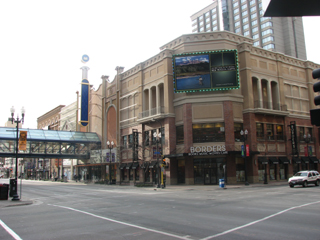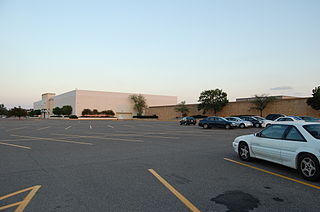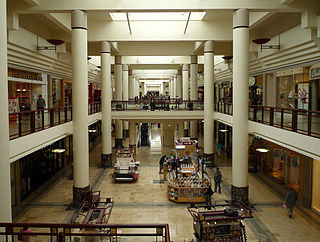Related Research Articles

Mall of America (MoA) is a large shopping mall located in Bloomington, Minnesota. Located within the Minneapolis–Saint Paul metropolitan area, the mall lies southeast of the junction of Interstate 494 and Minnesota State Highway 77, north of the Minnesota River, and across the Interstate from the Minneapolis–Saint Paul International Airport. It opened in 1992, and is the largest mall in the United States, the largest in the Western Hemisphere, and the twelfth largest shopping mall in the world.
Nicollet Mall is a twelve-block portion of Nicollet Avenue running through downtown Minneapolis, Minnesota, United States. It is a shopping and dining district of the city, and also a pedestrian mall and transit mall. Along with Hennepin Avenue to the west, Nicollet Mall forms the cultural and commercial center of Minneapolis.

Nicollet Avenue is a major street in Minneapolis, Richfield, Bloomington, and Burnsville in the U.S. state of Minnesota. It passes through a number of locally well-known neighborhoods and districts, notably Eat Street in south Minneapolis and the traffic-restricted Nicollet Mall in downtown Minneapolis.
Dayton's was an American department store chain founded in Minneapolis, Minnesota, in 1902 by George Draper Dayton. It operated several local high end department stores throughout Minnesota and the Upper Midwest for almost 100 years. Although it was regionally known as a high-quality shopping destination, Dayton's is best remembered for starting the discount shopping chain Target. The company was also instrumental in the history of shopping malls; opening the first indoor shopping mall in the United States, Southdale Center in Edina, Minnesota, in 1956.

Nicollet Mall station is a light rail station on the Metro Blue Line and Green Line in Minneapolis, Minnesota. Adjacent to the light rail platforms is the southbound Metro Orange Line bus rapid transit station Marquette & 5th Street.

Southdale Center is a shopping mall located in Edina, Minnesota, a suburb of the Twin Cities. It opened in 1956 and is both the first and the oldest fully enclosed, climate-controlled shopping mall in the United States. Southdale Center has 1,297,608 square feet of leasable retail space, and contains 106 retail tenants. The mall is owned by Simon Property Group and the anchor stores are Macy's, Dave & Buster's, AMC Theatres, Hennepin Service Center, and Life Time Athletic.

The Eden Prairie Center is a mall located in Eden Prairie, Minnesota. It has been managed by Jones Lang LaSalle as of 2020. It is anchored by JCPenney, Kohl's, Target, Von Maur and Scheels Sporting Goods.

Burnsville Center is located in Burnsville, Minnesota. It is one of the larger enclosed malls in Minnesota with 100 stores on 3 floors and approximately 1,100,000 square feet (100,000 m2). The mall opened in 1977 with three anchor stores, Sears, Dayton's, and Powers Dry Goods as anchors.
Donaldson's, previously known as the L. S. Donaldson Company, headquartered in Minneapolis, Minnesota, is a defunct department store company.
Crossroads Center is a shopping mall in St. Cloud, Minnesota, United States, and is the largest mall in the state outside the core Twin Cities metro area. Its six anchor stores are Macy's, JCPenney, Target, Scheels All Sports, HomeGoods, and DSW Inc. The Marshall Field's store (originally Dayton's was officially renamed Macy's on September 9, 2006.

Ridgedale Center, colloquially known as Ridgedale, is an enclosed shopping mall in Minnetonka, Minnesota, a western suburb of the Twin Cities. It is directly located off I-394/US 12 between Ridgedale Drive and Plymouth Road. Ridgedale Center comprises 1,105,337 square feet (100,000 m2) of leaseable retail space, and contains approximately 140 retail tenants. It is currently jointly owned by Brookfield Properties and CBRE Group, and managed by Brookfield. The anchor stores are JCPenney, Nordstrom, Macy's, and Dick's House of Sport.

Mayo Clinic Square on Block E in downtown Minneapolis, is a building bounded by Hennepin Avenue, North 6th Street, North 7th Street, and 1st Avenue North. It is part of the Downtown West neighborhood in Minneapolis, historically known as the Warehouse District. It is one block south of the Warehouse District/Hennepin Avenue light rail station on the METRO Blue and Green lines. "Block E" is a City planning department designation of the block; other blocks have similar designations

Northtown Mall is a shopping mall located in Blaine, Minnesota, United States. The mall's anchor stores are Hobby Lobby, Best Buy Outlet, 2 Becker Furniture World stores, and Burlington. In addition, Northtown Mall features over 100 stores and restaurants, as well as a food court and Paladin Career and Technical High School public charter school which was open in September 2002. The mall is owned by 4th Dimension Propertes. Over 5.5 million people visit the mall every year.
Shingle Creek Crossing, formerly Brookdale Center, is a regional shopping mall in Brooklyn Center, Minnesota. It became the third enclosed shopping mall in the Twin Cities, after Southdale Center and Apache Plaza. The mall opened in phases beginning with Phase One in March 1962 which included anchor stores Sears and JCPenney. Phase Two opened in 1966, adding Dayton's as the third anchor. Donaldson's became the fourth anchor in September 1967. Brookdale Center was part of "The Dales", what was referred to as the four "Dale" centers circling the Twin Cities, originally developed by Dayton-Hudson Corporation. The others are Southdale Center in Edina, Rosedale Center in Roseville and Ridgedale Center in Minnetonka. After a long decline, the mall closed in 2010 and was demolished in 2012 before being redeveloped into the Shingle Creek Crossing development.

Rosedale Center, commonly known just as Rosedale, is a shopping center in Roseville, Minnesota. The mall is surrounded by suburbs and close to major highways and serves a trade area population almost 2 million people, and boasts 14 million visitors annually.

Maplewood Mall is a super-regional shopping mall in Maplewood, Minnesota, United States. It is near Interstate 694 on the Saint Paul side of the Twin Cities metropolitan area. Maplewood Mall opened in 1974. It was later renovated and expanded in 1996. It is managed by Washington Prime Group of Columbus, Ohio. The mall's anchor stores are Barnes & Noble, JCPenney, Kohl's, and Macy's with one vacant anchor last occupied by Sears.

The 2010 Minnesota U.S. House of Representatives elections took place on November 2, 2010. All eight congressional seats that make up the state's delegation were contested. Representatives are elected for two-year terms; those elected will serve in the 112th United States Congress from January 3, 2011, until January 3, 2013.

Minneapolis City Center is a mixed-use shopping mall on Nicollet Mall in Minneapolis, Minnesota. It opened in 1983 and occupies the bottom three floors of the 33 South Sixth office building. Designed by Skidmore, Owings & Merrill, Minneapolis City Center contains 250,000 square feet (23,000 m2) of leasable retail space. The mall was built around the pre-existing Forum Cafeteria restaurant. The building is adjacent to the Marriott Hotel City Center and connected to the Gaviidae Common shopping mall.

False rumors of a police shooting resulted in rioting, arson, and looting in the U.S. city of Minneapolis from August 26–28, 2020. The events began as a reaction to the suicide of Eddie Sole Jr., a 38-year old black man who was being pursued by Minneapolis police officers for his alleged involvement in a homicide. At approximately 2 p.m. on August 26, Sole died after he shot himself in the head as officers approached to arrest him. False rumors quickly spread on social media that Minneapolis police officers had fatally shot Sole. To quell unrest, Minneapolis police released closed-circuit television surveillance footage that captured Sole's suicide, which was later confirmed by a Hennepin County Medical Examiner's autopsy report.

The Marq2 transit corridor is a north–south thoroughfare in Minneapolis, Minnesota, United States. It consists of the parallel streets of Marquette and Second avenues in the downtown area. Each public streetway has two contraflow bus lanes with two lanes available for general-purpose traffic in the opposite direction. Vehicular transit flows south on Marquette Avenue and north on Second Avenue. The inner curb lane allows buses to stop for riders, while the second bus-only lane allows buses to pass each other along the corridor. Bus routes that operate on the corridor stop at every other block at an assigned gate with each route assigned a northbound and southbound gate. Gates are assigned letters A, B, C, or D on Marquette Avenue and E, F, G, and H on Second Avenue. Custom bus shelters are installed at each stop with heaters and real time transit information. The corridor primarily serves express buses operated by all five public transit agencies in the Twin Cities.
References
- 1 2 "1 Jan 1902, Page 6 - Star Tribune at Newspapers.com". Startribune.newspapers.com. 1 January 1902. Retrieved 1 May 2022.
- 1 2 "22 Aug 1878, Page 4 - Star Tribune at Newspapers.com". Startribune.newspapers.com. Retrieved 1 May 2022.
- ↑ "18 May 1884, Page 14 - Star Tribune at Newspapers.com". Startribune.newspapers.com. Retrieved 1 May 2022.
- 1 2 "17 Oct 1886, Page 6 - Star Tribune at Newspapers.com". Startribune.newspapers.com. Retrieved 1 May 2022.
- ↑ "17 Jan 1885, Page 8 - Star Tribune at Newspapers.com". Startribune.newspapers.com. Retrieved 1 May 2022.
- ↑ "12 Jul 1885, Page 7 - Star Tribune at Newspapers.com". Startribune.newspapers.com. Retrieved 1 May 2022.
- ↑ "17 Oct 1886, Page 9 - Star Tribune at Newspapers.com". Startribune.newspapers.com. Retrieved 1 May 2022.
- ↑ "20 Jul 1887, Page 5 - Star Tribune at Newspapers.com". Startribune.newspapers.com. Retrieved 1 May 2022.
- ↑ "16 Jul 1887, Page 6 - Star Tribune at Newspapers.com". Startribune.newspapers.com. Retrieved 1 May 2022.
- ↑ "1 Apr 1893, Page 5 - Star Tribune at Newspapers.com". Startribune.newspapers.com. Retrieved 1 May 2022.
- ↑ "2 Jan 1894, Page 2 - Star Tribune at Newspapers.com". Startribune.newspapers.com. Retrieved 1 May 2022.
- ↑ "21 Mar 1894, Page 5 - Star Tribune at Newspapers.com". Startribune.newspapers.com. Retrieved 1 May 2022.
- ↑ "3 Dec 1901, Page 4 - The Minneapolis Journal at Newspapers.com". Startribune.newspapers.com. Retrieved 1 May 2022.
- 1 2 "8 Oct 1915, Page 10 - Star Tribune at Newspapers.com". Startribune.newspapers.com. 8 October 1915. Retrieved 1 May 2022.
- ↑ "14 Dec 1904, Page 1 - The Minneapolis Journal at Newspapers.com". Startribune.newspapers.com. 14 December 1904. Retrieved 1 May 2022.
- ↑ "15 Dec 1904, Page 2 - Star Tribune at Newspapers.com". Startribune.newspapers.com. 15 December 1904. Retrieved 1 May 2022.
- ↑ "23 Apr 1905, Page 7 - Star Tribune at Newspapers.com". Startribune.newspapers.com. 23 April 1905. Retrieved 1 May 2022.
- 1 2 "22 Sep 1906, Page 1 - The Minneapolis Journal at Newspapers.com". Startribune.newspapers.com. 22 September 1906. Retrieved 1 May 2022.
- ↑ "28 Mar 1907, Page 9 - Star Tribune at Newspapers.com". Startribune.newspapers.com. 28 March 1907. Retrieved 1 May 2022.
- ↑ "4 Jan 1909, Page 7 - Star Tribune at Newspapers.com". Startribune.newspapers.com. 4 January 1909. Retrieved 1 May 2022.
- ↑ "26 May 1909, Page 1 - Star Tribune at Newspapers.com". Startribune.newspapers.com. 26 May 1909. Retrieved 1 May 2022.
- ↑ "Star Tribune 27 May 1909, page Page 7". Newspapers.com. Retrieved 22 December 2023.
- ↑ "The Minneapolis Star 26 Nov 1935, page Page 1". Newspapers.com. Retrieved 22 December 2023.
- ↑ "Star Tribune 30 Dec 1915, page Page 12". Newspapers.com. Retrieved 22 December 2023.
- ↑ "Star Tribune 26 May 1916, page Page 11". Newspapers.com. Retrieved 22 December 2023.
- ↑ "Star Tribune 15 Oct 1924, page Page 19". Newspapers.com. Retrieved 22 December 2023.
- ↑ "Star Tribune 19 Apr 1961, page Page 18". Newspapers.com. Retrieved 22 December 2023.
- ↑ "The Minneapolis Star 01 Apr 1937, page Page 18". Newspapers.com. Retrieved 22 December 2023.
- ↑ "The Minneapolis Star 30 Aug 1950, page Page 11". Newspapers.com. Retrieved 22 December 2023.
- ↑ "Star Tribune 02 May 1954, page Page 47". Newspapers.com. Retrieved 22 December 2023.
- ↑ MNHS Library
- ↑ "The Minneapolis Star 23 Jun 1967, page Page 17". Newspapers.com. Retrieved 22 December 2023.
- ↑ "The Minneapolis Star 07 Aug 1958, page Page 1". Newspapers.com. Retrieved 22 December 2023.
- ↑ "The Minneapolis Star 16 Mar 1960, page Page 25". Newspapers.com. Retrieved 22 December 2023.
- ↑ "Star Tribune 23 Feb 1966, page Page 7". Newspapers.com. Retrieved 22 December 2023.
- ↑ "The Minneapolis Star 08 Mar 1966, page Page 40". Newspapers.com. Retrieved 22 December 2023.
- ↑ "Star Tribune 05 May 1971, page Page 9". Newspapers.com. Retrieved 22 December 2023.
- ↑ "Star Tribune 17 Nov 1971, page Page 1". Newspapers.com. Retrieved 22 December 2023.
- ↑ "Star Tribune 18 Jun 1972, page Page 50". Newspapers.com. Retrieved 22 December 2023.
- ↑ "Star Tribune 18 Jun 1972, page Page 49". Newspapers.com. Retrieved 22 December 2023.
- ↑ "The Minneapolis Star 11 Oct 1972, page Page 92". Newspapers.com. Retrieved 22 December 2023.
- ↑ "Star Tribune 19 May 1972, page Page 4". Newspapers.com. Retrieved 22 December 2023.
- ↑ "The Minneapolis Star 04 Jun 1974, page Page 100". Newspapers.com. Retrieved 22 December 2023.
- ↑ "Star Tribune 26 Feb 1976, page Page 5". Newspapers.com. Retrieved 22 December 2023.
- ↑ The Minneapolis Star
- ↑ "Star Tribune 07 Mar 1976, page Page 45". Newspapers.com. Retrieved 22 December 2023.
- ↑ "Star Tribune 31 Jul 1977, page Page 12". Newspapers.com. Retrieved 22 December 2023.
- ↑ "Star Tribune 04 Jun 1985, page Page 1". Newspapers.com. Retrieved 22 December 2023.
- ↑ "Star Tribune 04 Nov 1985, page Page 111". Newspapers.com. Retrieved 22 December 2023.
- ↑ "Star Tribune 28 Aug 1987, page Page 1". Newspapers.com. Retrieved 22 December 2023.
- ↑ "Star Tribune 06 Jan 1995, page Page 1". Newspapers.com. Retrieved 22 December 2023.
- ↑ "Star Tribune 10 Jun 2004, page Page A1". Newspapers.com. Retrieved 22 December 2023.
- ↑ Northtown Mall
- ↑ "Maplewood Mall: Maplewood, MN". 7 July 2009.
- ↑ "Eden Prairie Center turns 40". 17 March 2016.
- ↑ "JC Penney closing 154 stores (Including 4 in MN) in first post-bankruptcy phase". 5 June 2020.
- ↑ "Gordmans in Burnsville, Woodbury to close unless bankrupt owner can find buyer". Star Tribune .
- ↑ "Luxury apartments to rise 26 stories on Nicollet Mall | Star Tribune".